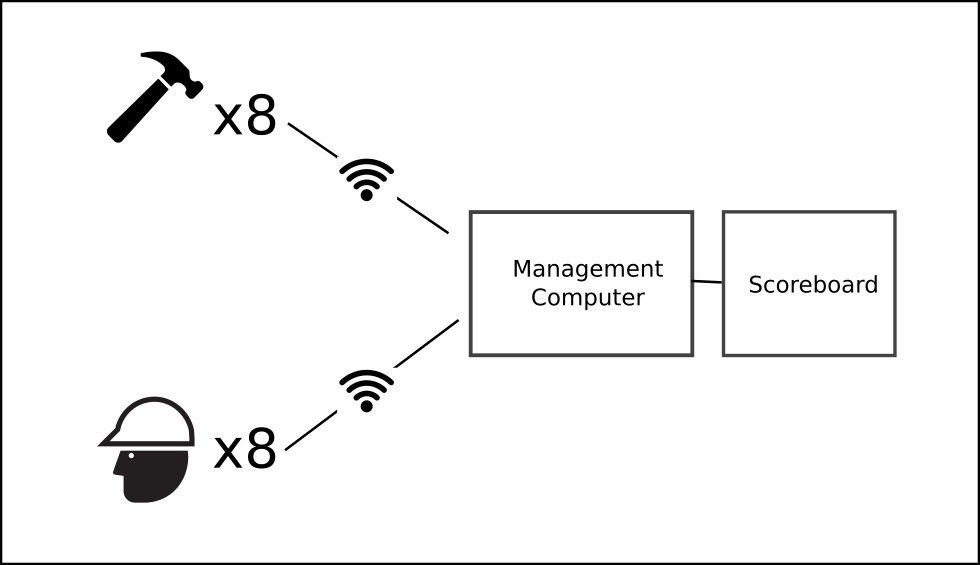
The system comprises of three elements:
- Hammer - The unit held by the player's hand.
- Hat - The unit the player wears on his/her's head.
- Management Computer - A computer managing the game. It is connected to a scoreboard, showing live player score and status.
All the units connect on a private WiFi network. The endpoint units (hammers and hats) contain a WiFi embedded module, and the management computer, which can be either a Raspberry Pi or a PC acts as as an access point. The management computer is also responsible for managing the scoreboard, which is currently implemented as a graphic screen on the video output, which is presented to the players through a large screen TV or a projector.
Endpoint units
There are two types of endpoint units - hammers and hat. Even though they differ in their form and role in the game, they are very similar in their electronic functionality. An endpoint should be:
- Powered by a battery
- Able to connect to a WiFi network
- Able to change its color
- Able to sense a hit
The commonality between the endpoint types suggests that they can share one electronic design and one printed circuit board type.
The ability to change colors is easily accomplished by RGB LEDs. It should be noted that it is not strictly required that the hammer color should be changeable - it could be simply painted with some fixed color (the color of the hammer does not change during the game). I chose to make it dynamic mainly for the flexibility of unit replacement - if a unit fails, it can be easily replaced be a different one without worrying about making it have the correct color.
The battery requirement is trivial, but battery selection is not. The first intent was to operate all the endpoint units from non-rechargable, double AAA battery. The reason is that I didn't want to spend time on charging batteries, and there are a lot of them! In practice this design choice has been proven wrong for several reasons. I'll devote a separate project log for that.
WiFi Connectivity
When WiFi connectivity requirement is raised, ESP8266 is an immediate contender. In this project I chose to take a different route and selected the TI CC3200, mounted on a board called WiFi Micro, made by RedBearLab. The CC3200 is a powerful WiFi integrated microcontroller. It has much more I/O and features than the ESP8266, but is also much more expensive. Thankfully, the great folks at RedBearLab agreed to give me those boards with substantial discount, showing a continuous support in Open Source projects.
The last requirement, namely hit detection, is somewhat tricky. I'll devote a separate project log to discuss it.
 avishorp
avishorp
Discussions
Become a Hackaday.io Member
Create an account to leave a comment. Already have an account? Log In.
IR requires line of sight. In a room full of people running around, that requirement is hard to meet.
As to the RF option, I definitely considered it. The major problem is that it would also required some unit connected to the management computer, allowing it to transmit and receive data. The WiFi option allows me to use any computer with no additional hardware - I'm doing the development on my laptop with intent of migrating to RPi3. The management software communicates directly with the endpoint without additional broker in-between.
Regarding hit detection - I am using piezo sensor, I'll have another project log on that topic. Since it's mounted on a person's head, it must be soft, It's not supposed to be violent ...
Thanks for your comments, keep following!
Are you sure? yes | no